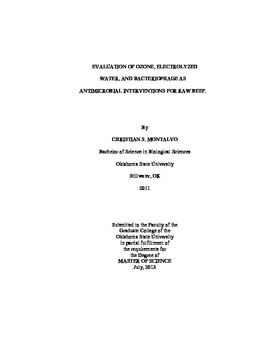| dc.contributor.advisor | Muriana, Peter M. | |
| dc.contributor.author | Montalvo, Christian Sarah | |
| dc.date.accessioned | 2014-09-24T14:18:35Z | |
| dc.date.available | 2014-09-24T14:18:35Z | |
| dc.date.issued | 2013-07-01 | |
| dc.identifier.uri | https://hdl.handle.net/11244/11172 | |
| dc.description.abstract | Escherichia coli O157:H7 and Salmonella are frontrunners in many foodborne outbreaks, specifically those involving raw beef. Usually an easy way to prevent illness from occurring is essentially by cooking foods to the proper temperature, which would kill any lingering pathogens. Unfortunately a lot of processing methods are starting to use applications such as needle tenderization, maceration, and even brine injections to produce increasingly palatable products. This allows any bacterial or potential pathogens that would just be found on the outer pieces of the meat to be relocated into the sterile inner tissues (i.e., `translocated'), which presents a serious issue when a consumer requests a cut of meat not to be cooked all the way through. The USDA-FSIS refers to such products as `non-intact' (U.S. Department of Agriculture, 1999). Due to the increase of foodborne illnesses there has been much research towards innovative antimicrobials and disinfection methods for foods and surfaces in processing areas (Guentzel et al., 2008). The objective of these studies was to measure the effectiveness of three popular antimicrobial solutions (ozone, electrolyzed water, and bacteriophage) as potential interventions against E. coli O157:H7 and/or Salmonella spp. on carcasses and meat surfaces that would be subsequently subjected to blade tenderization. Our research suggests that both ozone and electrolyzed water will not serve as an effective antimicrobial if directly applied to beef, whether for carcass application or non-intact beef cuts. This is because the studies we performed indicate that both ozone and electrolyzed water are rendered ineffective by organic material (i.e. beef). Our research also proposes that although bacteriophage demonstrated modest reductions in our trials, they may not be widely applicable due to the difference of sensitivity to various strains. | |
| dc.format | application/pdf | |
| dc.language | en_US | |
| dc.publisher | Oklahoma State University | |
| dc.rights | Copyright is held by the author who has granted the Oklahoma State University Library the non-exclusive right to share this material in its institutional repository. Contact Digital Library Services at lib-dls@okstate.edu or 405-744-9161 for the permission policy on the use, reproduction or distribution of this material. | |
| dc.title | Evaluation of Ozone, Electrolyzed Water, and Bacteriophage As Antimicrobial Interventions for Raw Beef. | |
| dc.type | text | |
| dc.contributor.committeeMember | McGlynn, William | |
| dc.contributor.committeeMember | Jaroni, Divya | |
| osu.filename | Montalvo_okstate_0664M_12997.pdf | |
| osu.accesstype | Open Access | |
| dc.description.department | Food Science | |
| dc.type.genre | Thesis | |
